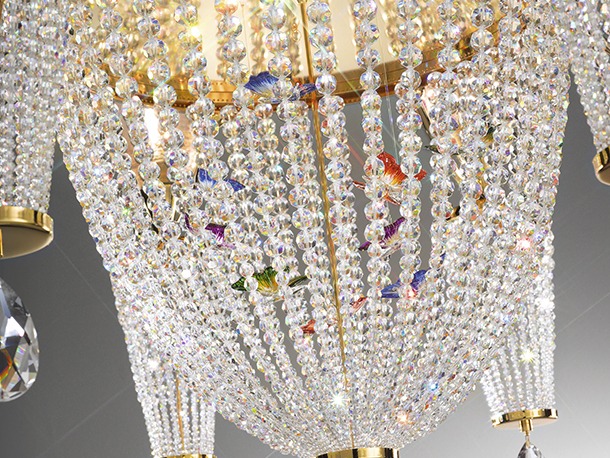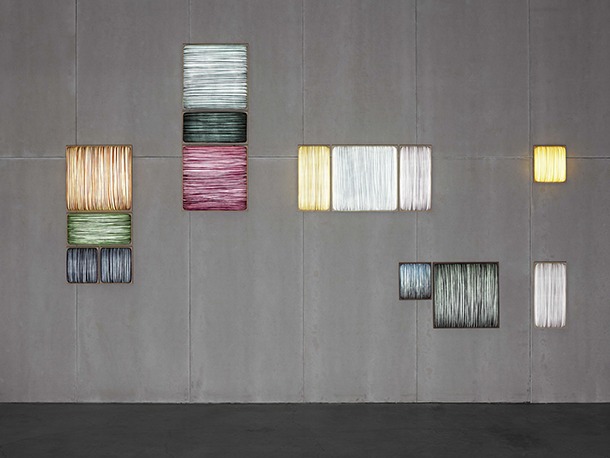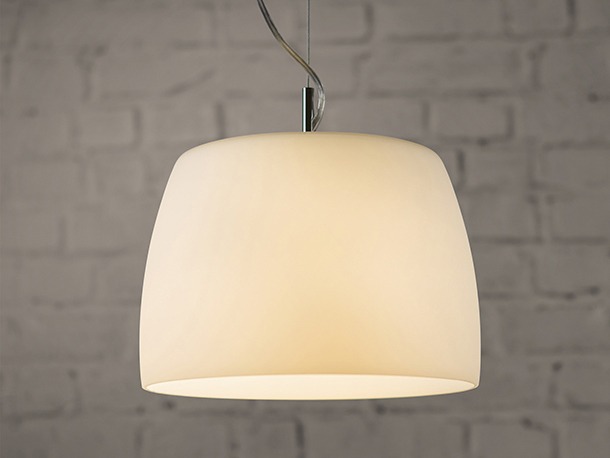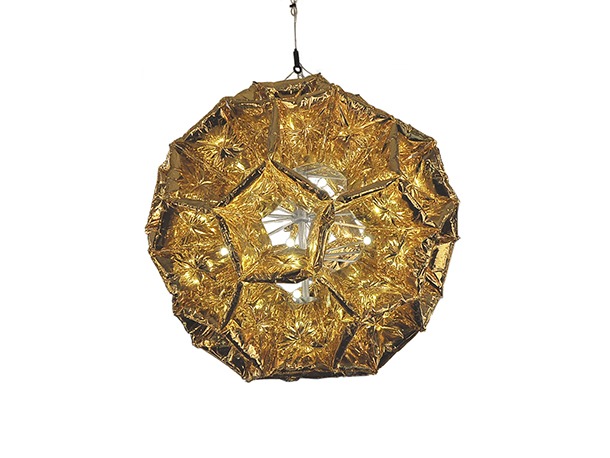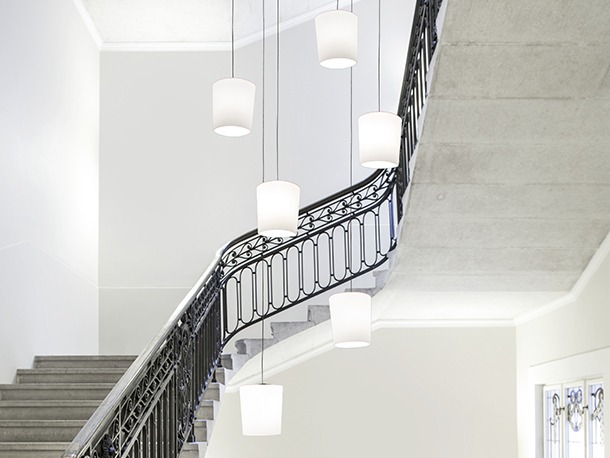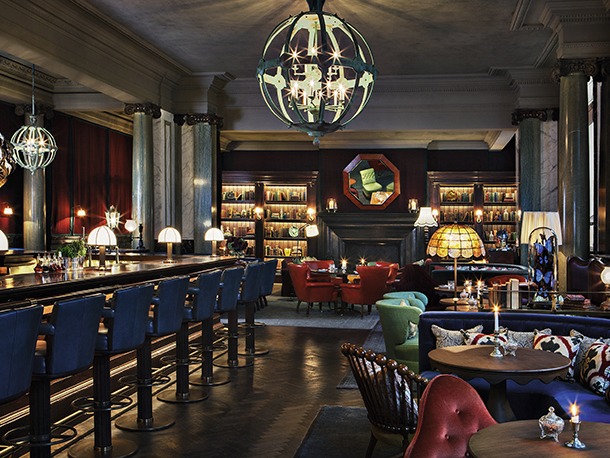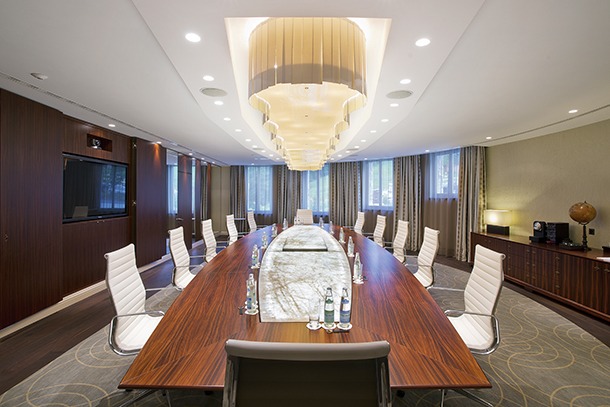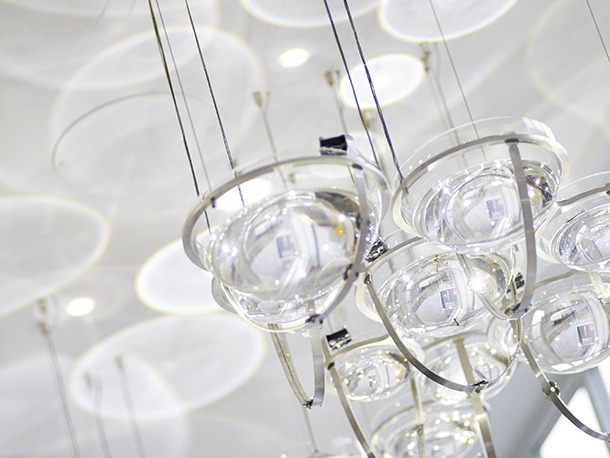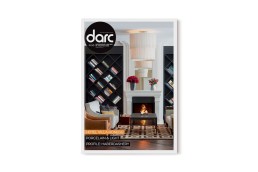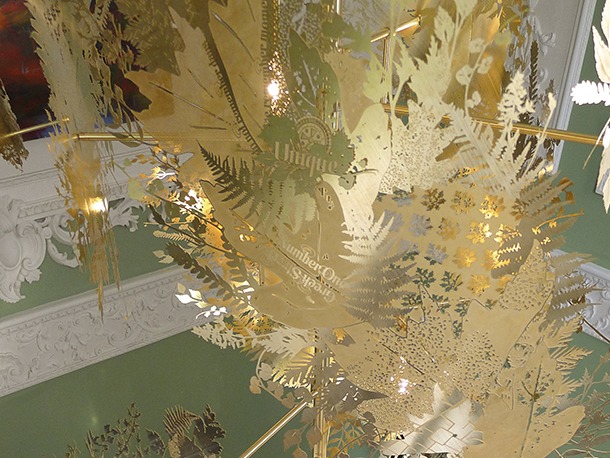Farfalla
New from Kolarz, the Farfalla light is a twist on the classic crystal chandelier, with hand painted multi-coloured butterflies interspersed among the crystals. Designed and manufactured in Europe, the Farfalla features Kolarz crystals, 24 carat gold plating and hand painted murano glass.
Simon Says
Simon Says, the newest member of the Mino Collection, combines clean straight lines with Aqua’s signature natural silk. The lamps work as single pieces or in groups of various sizes and colours. The proportions make Simon Says perfect for either narrow spaces, or for more complex light installations.
Nimis
Nimis is one of a new collection of opal glass pendants from Astro. The piece’s soft aura complements the pool of light that it casts below and the clean, simple style of its design. Suspended by a simple strand of wire enwrapped by an elegant twist of flex, it is equally suited to contract and domestic settings.
Dent 200
Dent 200, developed by designer Chak, is a whopping two metre wide chandelier in the shape of a truncated icosahedron. Constructed from polyethylene, the piece has a lustre that draws paralells between the worlds of fabric and blown metal. A white version will be launched at Light + Building.
Chorus Mini
2014 sees the launch of the Chorus Mini, which is, as the name suggests, a new smaller version of Prandina’s blown glass pendant. The miniture size has been created to enable its installation in a wider variety of configurations allowing it to adapt to different kinds of spaces.
Rosewood London
Rosewood London opened late last year becoming the first European presence for the ultra-luxury Rosewood Hotels & Resorts group. Located in Holborn, where the bustling areas of the City and West End meet, the hotel is the result of a sensitive transformation of the 1914 Edwardian Belle Epoque building that was previously known as Chancery Court.
Designed by H. Percy Monckton, the original structure was completed in 1914 and has, in the years since, undergone four subsequent expansions, completed durings its half century as the headquarters for the Pearl Assurance Company.
The most recent transformation of this historic building from Imperial-era offices into a London luxury hotel was carried out under the guidance of English Heritage, which lists the principal facades, as well as the interiors of the former East and West Banking Halls (now Holborn Dining Room and the Bar, respectively) and the Grand Staircase as the hotel’s significant heritage features.
The guiding philosophy of Rosewood Hotels & Resorts is to design each property so that it reflects the history, culture and sensibilities of a particular location. At Rosewood London this meant that when it came to interior design and lighting for the most prominent public areas, the bar and restaurant at the front of the hotel, it was essential to select a company that would be sensitive to the building’s history and culture as well as its technical requirements.
For the bar area, dubbed Scarfes Bar, Martin Brudnizki Design transformed the space into a warm and vibrant environment taking inspiration from the atmosphere of a drawing room and the sophistication of a gentleman’s club. Optimising the building’s heritage, original architectural features were retained to ensure the space had a strong sense of history. Throughout the bar, vintage furnishings were mixed with custom designed pieces, allowing guests to continually discover new elements of the design. The lighting was produced by London-based, bespoke lighting specialists Dernier & Hamlyn, a company whose own history spans back to 1888.
A series of two metre high globe lamps were produced, each hand finished with a patina paint effect to mimic weathered brass. These were actually created using a variety of materials with aluminium dominating to ensure that they were within the specified weight limits. The largest of these chandeliers provides an eye-catching feature for the space and is complemented by smaller versions, located in other areas of the room.
Along the bar are lamps formed from solid brass and finished in a hand bronze by the Dernier & Hamlyn team. The glass was hand blown in opal glass with a thin metal framework again made in brass and finished to match.
The bar is already becoming one of the most exciting places to drink in London and the recently opened Holborn Dining Room is set to achieve the same on the eating front. Again this space was designed by Martin Brudnizki Design with lighting from Dernier & Hamlyn. Formerly the East Banking Hall of Pearl Assurance it is a smart, bustling brasserie with a menu of simple yet sophisticated British dishes.
The lighting here emulates that same simple yet sophisticated effect. Blackened steel oval frames some seven metres long are given the required support by sub frames and required mixed construction methods that incorporated both laser cutting and making sections by hand. These chandeliers also accommodate LED emergency lighting discreetly fitted to the cross section bars in order not to detract from the intended visual impact.
The requirement for the main lighting was large 120mm globe lamps. LED was requested, but despite a global search the team found no options that could supply the quality, light colour and visual appearance that was required. Instead the LED lamps had to be custom made. This was a lengthy process that needed detailed and protracted discussions between the interior designers, the lighting manufacturers and the lamp production company, Heritage Lighting, to develop lamps that met all technical and aesthetic requirements. But as Garrow Seal of Martin Brudnizki explains, the finished effect was well worth the effort. “We have worked with Dernier & Hamlyn on many projects and continue to select them whenever we want the best quality bespoke lighting for high end hospitality clients,” he says. “Their range of manufacturing skills and focus on producing the best possible solutions to our design briefs was evidenced yet again for Rosewood London’s lighting and both we and the client are delighted with the results.”
La Ferme Saint-Simon
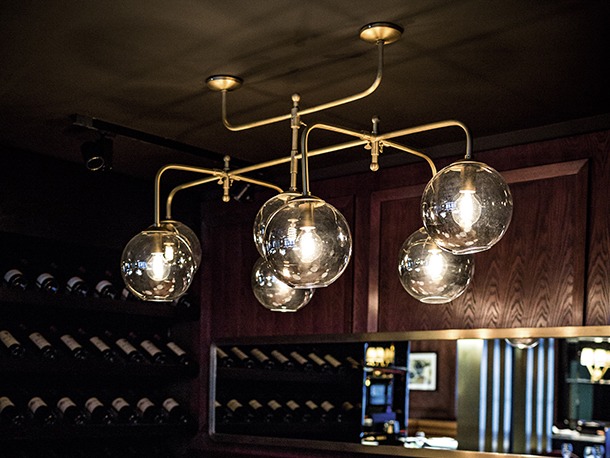
La Ferme Saint-Simon sits in the famous Saint-Cermain-de Prés neighbourhood of Paris’s Left Bank. Its location between embassies, ministries, publishing houses and world famous galleries has long made the restaurant a place of political and intellectual meetings.
In 2013, the restaurant entered a new chapter under the ownership of master sommelier Laurent Limouzin and Franco-Argentinian architect and designer Marcelo Joulia. Naturally, Joulia’s own practice Naço Architectures undertook a complete rejuvenation of the space, with furniture, rugs, dishes and lighting all custom designed to give the venue a ‘modern classicism’.
Specially created light fixtures were created for key spots within the restaurant: one above the premium table in the main room, and one in each of the private dining rooms, the Champagne Room and the Bourgogne Room.
Created by French artisans in their workshop just outside Paris, each piece comprises a different configuration of brushed brass piping: long linear section with neat 90-degree bends. Spherical balls of blown glass hang at the tips of these brass sections. A slight metallic sheen gives each globe a reflective, mirrored effect when not in use. When illuminated, the traditional incandescent bulb within gives each shade a smoky glow, while directing an intimate glow onto the tables below.
This lighting complements the other bespoke elements within the space to help deliver a sophisticated air of elegant warmth.
Hotel Villa
Perched 1000 metres up, atop Mount Bürgenstock, the Hotel Villa Honegg boasts some of the most majestic views in Switzerland. Built in 1905 in the rare Scandanavian ‘Gustavian’ style, the five-storey chalet style hotel recently completed an extensive refurbishment by Jestico + Whiles, delivering a fresh look for its suites, guest rooms and communal spaces.
The design team were drawn by the golden light that porcelain casts over an interior and commissioned Boatswain Lighting to produce a series of chandeliers for the hotel’s lounge and board room. They chose a two-tier Drum chandelier with long vertical filaments that juxtapose the diagonals of the shelves. As a place of relaxation, the lounge suited the subtle tones of warm light that a porcelain piece provides. Even when not illuminated the chandelier’s ivory ceramic blends well with the colour scheme.
Inspired by a Boatswain installation at the Lutyens Restaurant in London, the design team decided to use a further piece in the Hotel’s board room. Despite an established reputation for lighting restaurants and convivial leisure spaces, this was the first time one of Boatswain’s designs had been used in a business meeting room setting. Their Nuage light feature softened the metal and marble and added an important ingredient of hospitality to formal surroundings.
As Boatswain Lighting’s General Manager Jason Boatswain notes, the pieces chosen proved the perfect bridge between traditional and contemporary design aesthetics. “The Hotel Villa Honegg was envisaged as a luxurious private retreat, a place you can escape modern life without leaving modernity behind,” he says. “The contemporary porcelain design offered the ideal tone of light with a style that proved easily compatible with the rejuvenated interior.”
Il Lago Dei Cigni,
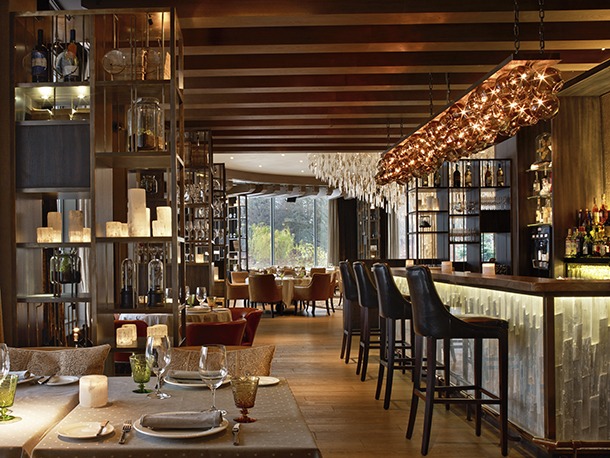
Krestovsky Island sits at the heart of St Petersburg, just one of several urban islets formed by the tangle of distributaries at the mouth of the Neva River. Its long-held role as a playground for Petersburgtsy and its emerging status as one of the city’s most desirable suburbs made it the ideal location for Il Lago dei Cigni, the new restaurant from the owners of Buddha Bar St. Petersburg.
The venue lies within a wooden space at the tip of the island. Situated, appropriately enough, on the shores of Lake Lebiazhie and next to the ‘Swan House’, a shelter for the island’s birdlife, it boasts floor-to-ceiling windows which look out across the water.
Gallery HBA - a studio within HBA London that is dedicated to high-concept bespoke interior design - was asked to create an interior scheme that would weave together this lakeside setting with elements of Russian folklore as well as Tchaikovsky’s Swan Lake, the ballet from which the restaurant takes its name.
Gallery HBA worked alongside lighting design practice MBLD to ensure the finished installation achieved the right aesthetic. “There were atmospheric lighting effects we wanted to achieve, especially at night, so working with a lighting designer helped ensure we could bring the vision we imagined into reality,” explains Inge Moore, Principal and Creative Director of The Gallery HBA.
A key example of this collaboration is found in the main dining area where a central column and chandelier combine to form a stylised ‘maypole’ feature. A pillar clad in clefts of natural selenite rock crystal disappears into the circular backlit soffit in the ceiling, and ‘ribbons’ of crystals interspersed with geometric copper wire talismans cascade from the round ceiling canopy. Following advice from MBLD, these are illuminated by 2700K LED downlights from UK manufacturer Light Graphix.
The Gallery’s design concept for Il Lago Dei Cigni also references Peter the Great’s vision for his new capital, St. Petersburg. During his rule, the tsar transformed the city into a ‘Venice of the North’, investing in palaces, engineering and shipbuilding to create a glittering attraction for European architects, scientists and thinkers. This spirit of intellectual pursuit has been interpreted in the introduction of timber cabinets displaying an array of curiosities, as if scientific specimens meant for inspection. Bespoke art fixtures have been crafted from magnifying glasses placed in front of wine bottle labels, glass domes exhibit mounted beetles or butterflies, and bundles of timeworn French manuscripts have been bound together with string into parcels. Set amongst this eclectic collection are candle-effect lamps, selenite shades containing light sources created by Mike Stoane Lighting.
Tucked away behind sliding timber doors, Il Lago de Cigni’s private dining space is a cosy haven illuminated by a glass chandelier piece from Czech manufacturer Preciosa. This echoes a linear version of the piece installed above the bar. Both comprise semi-bespoke, tinted glass globes. Though similar to a standard offering from the Preciosa range, The Gallery worked with the manufacturer to develop the clusters’ colourations; individual sphere sizes, quantities and configurations; and the lengths of their mounting trays. In addition, The Gallery consulted with MBLD about any technical modifications required in the wattage, voltage, lamping and placement – in this case, 10 watt tungsten halogen sources from Osram were used.
As MBLD Managing Director Rob Honeywill notes, proper consideration of the lighting was essential in delivering a satisfactory finish. “The intensity and colour rendition of the lighting enhances the core narrative of the interiors by helping create the mood and atmospheric effects desired by The Gallery,” he says. “MBLD recommended lighting specifications that would embellish the furnishings and design elements such as the maypole, amplifying their prominence within the overall design. The vibe at Il Lago dei Cigni shifts throughout the day due to the lighting levels. During the afternoon, the abundant sunlight creates an airy, natural feel, even when it is fainter on wintery days. As the sun goes down, the interior lighting brings warmth, drama and sparkle to the ambience.”
CP Hart
When bathroom design specialist C.P. Hart embarked on the creation of a new Chelsea showroom, they were keen to adopt a fresh approach. The in-house design team worked in partnership with retail design consultancy i-am Associates to create a space that embraces technology to deliver a dynamic, high-end experience for the Chelsea design community. Key to the completed scheme is a series of bespoke water-and-light sculptures by Jason Bruges. Comprised of clear, water-filled glass hemisphere lenses hanging from the ceiling and a hidden system of computer-controlled LEDs and fans, the sculptures magnify and refract ripples of light across the ceiling.
Since its inception in 2002, London-based Jason Bruges Studio has earned a reputation for delivering left-field installations that engage and intrigue. “We’re a studio that crosses the boundaries of art, architecture and interaction design,” Bruges explains. “For the C.P. Hart Chelsea project we have suspended a series of water pixels from the ceiling, which have been choreographed to animate and create auroras of light around the sculpture itself. Each of the glass bowls acts as an individual pixel and is then animated through pulse width modulated control. We see extraordinary lighting effects as a result of this animation. This has been a brilliant opportunity to explore using water as a digital medium; blurring the boundaries between natural resources and the application of digital technology is an exciting arena, and we are thrilled to have been able to create an interactive, magical space.”
The showroom also features two large media walls, which have been integrated into the fabric of the showroom. The ground floor level screen plays content inspired by water and movement, also designed by Jason Bruges, whilst the consultation hub in the basement features an interactive screen that enables architects, designers and consumers to create digital mood boards for their project.
As i-am’s Lead Designer James Coates notes, the combination of these various elements deliver on C.P. Hart’s request for a ‘next generation’ showroom environment: “By deconstructing the typical ‘room set’, blending physical display with digital presentations, maximising product presentation in limited space and incorporating the ‘water flow’ sculpture, the showroom design becomes a distinctive and memorable brand statement.”
ISSUE SIX
INSIDE ISSUE #06:
Rosewood Hotel • London //
Il Lago Dei Cigni • St Petersburg //
The Terrace • London //
CP Hart • London //
La Ferme St-Simon • Paris //
Profile: Haberdashery //
Folio: Moreysmith //
Comment: The Perfect Glow //
Porcelain Gallery //
Hotel Villa Honegg • Mount Bürgenstock //
Calendarc //
May Design Series Preview //
Design Lighting Tokyo //
Northern Light Fair //
Maison et Objet //
Light + Building Preview //
If...
Profile: Haberdashery
Too often in the world of interior design, the search for a truly unique and innovative lighting piece concludes with an installation that falls well short of the mark. Whether through budget constraints or a lack of daring, quality design and genuine originality are side-stepped in favour of the safe, standard option. For London-based design house Haberdashery, this ‘safe and standard’ approach is anathema. A collaborative team of artist-designers, engineers and image makers, their work spans lighting products, technical artworks and light-based experiences, delivering innovative design solutions to projects around the the world.
The studio was formed six years ago by directors Ben Rigby, Daniel Siden and Mac Cox. Hailing from a mix of disciplines – Rigby and Cox worked in the film industry and Siden has a background in industrial design – the trio were brought together by a shared interest in narrative driven design, design that exists beyond the mere decorative.
“We had a lot of overlapping interests – mostly around light – and felt we could achieve much bigger, more exciting projects if we pooled our resources as freelancers and started a company,” explains Rigby.
Initially the team adopted a broad, work-led approach, taking on a variety of projects from retail design for companies like Selfridges, to specialist product and lighting design for the British Film Institute. But it was a commission from luxury property developers Candy & Candy that provided a new, defined focus for the studio. The team were asked to produce a series of lighting sculptures for a number of Candy & Candy’s sites, including the One Hyde Park apartments in London. The success of these pieces proved the catalyst for an explosion of similar commissions from a host of interior designers within the ultra-high-end luxury market, and increasingly the hotel and hospitality sector.
With backgrounds in both the technical and aesthetic sides of design, the studio is able to marry together traditional and modern technologies and techniques to produce truly original pieces, delivered on time and installed by the team themselves.
“More and more we’re realising that even though we’re essentially offering an artwork, it also needs a maintenance manual and warranty,” says Rigby. “So we try to make things that are easy to maintain and clean, with lighting elements that are easy to replace. All of this helps endear you to the developers and architects of the world who just want things that won’t be a headache for them later on.”
Their installation at London-based charity The House of St Barnabas exemplifies their approach. Haberdashery created a six metre high sculpture for the main foyer of the building, a Grade 1 listed Georgian house in the heart of Soho, operated by the charity as a non-profit private members club. The piece comprises 50 photo-etched brass leaves built into an energetic spiral formation. Each leaf features visual elements that reflect the history and ethos of the club, specifically its work supporting London’s homeless.
“We like reinventing something traditional and making it really echo the space that it’s in,” says Rigby. “The Saint Barnabas piece is a good example of where we’ve taken a modern technique – in this case photo-etching, a technique generally used in high-tech engineering – and repurposed it to create something very decorative. And it’s a good example of how the piece and the space that it’s in work really well together.” [watch video]
Tiny points of light are built into the structure of the piece. Produced in-house, these LED sources are set within individual, photo-etched structures, pre-cut as flat pieces and then hand-folded into neat diamond shapes, each with its own heat sink.
“Often we’ll make our own lighting sources and cooling elements just because it’s hard to find something on the market that is the right size or is elegant enough,” says Rigby. “Generally, if there isn’t spotlights illuminating our work, it’s got custom lights within it, and we’d rather make those lights ourselves so that we can highlight the surfaces and the form exactly as we want.”
This uncompromising approach to achieving unique solutions also translates to the types of jobs the studio takes on. “The industry is full of photographs of each other’s work, circulating, looking for the best price,” notes Rigby. “It’s a horrible way of working and we try very hard to stamp our own unique thoughts on each new project. In fact, if possible, we get involved as early as we can on a project and help develop the brief with a client and perhaps push it a little bit further, hopefully even more so in the future when we find the right architectural lighting company to strategically align with on the bigger, more exciting projects”.
Having established a strong reputation in the luxury interior market and with over 200 bespoke designs under their belt - mostly for private residences - the studio is now turning its attention toward larger architectural practices and to projects that might incorporate short runs rather than one-off pieces.
“Every bespoke design we make is essentially a prototype, so there’s a lot of R&D that goes into each one,” says Rigby. “We learn lots of interesting things along the way about materials, how light plays off surfaces and reflection and we then feed that back into the next round of designs.”
Recognising the importance of experimentation, the studio recently set up HabLab - an internal process that allows the whole team to flex their creative muscles unfettered by an external client brief. Every ten weeks, staff are invited to submit proposals for interesting, in-house projects. From this pool of ideas (predominantly, though not exclusively, lighting related), two are chosen to take forward – one selected by an office-wide vote, the other by the three directors. Each is given a small development budget and revisited after ten weeks. “Sometimes a little bit of interesting research pops up, which is shelved until the right client project comes along, but our first round of projects has also turned up potential products which we then fund to the next stage.”
Indeed the development of limited run products is a key part of Haberdashery’s expanding focus. Mobile Light is their first official product to be taken forward to manufacture. A minimalist, Bauhaus-inspired fixture, Mobile Light’s structure pivots around three points allowing it to adapt to a variety of spaces. Straddling the worlds of decorative and functional lighting, the piece is envisaged as a comfortable fit for offices and bedrooms alike.
With its widening creative scope and a new Hong Kong office set to launch at the end of the year, Haberdashery, it seems, has hit its stride.
“We try to be very well organised and well structured as a company so we can allow people the breathing space to be creative - you can’t have one without the other,” Rigby notes. “We’re a very tight ship and everything’s project managed within an inch of its life, but great things come out of that.”
Further viewing:
Commissioned by the exclusive private members club Home House, Haberdashery designed and developed, Tempête , two sister sculptures, a construction of black rod shapes, centrally suspended in the Home House dining rooms.
The team also created four bespoke pieces for Katharine Pooley at ‘The Gate’ in Doha (right and bottom), including the porcelain light sculpture Leaves. [watch video]
Mobile Light pendants were inspired by Bauhaus minimalism and the constructivist line drawings of Russian artist El Lissitzky. Hand built in steel, bronze, glass and aluminium, the Mobile Light’s three pivot points means that it can be formed into many different shapes.
Haberdashery were commissioned to design the festive lighting scheme for Cricklewood district as part of the Design For London initiative. The lighting scheme consisted of 40 individual street-post mounted festive light sculptures that complemented the associated works by Polimekanos and GortScott Architects.
A product of the HabLab process, Freq. was a home made exhibition, created in collaboration with photographer Julian Abrams. LEDs and polished stainless steel were used to produce the five sculptures on show, each with varying patterns, from the highly complex to the very simple. These were shown beside 14 editioned photographic prints, capturing the complex patterns of these sculptures. [watch video 1] [watch video 2]

